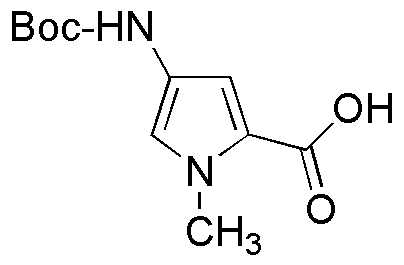4-(Boc-amino)-1-methyl-1H-pyrrole-2-carboxylic acid is widely utilized in research focused on:
- Peptide Synthesis: This compound serves as a key building block in the synthesis of peptides, allowing researchers to create complex molecules for pharmaceutical applications.
- Drug Development: It plays a significant role in the development of new drugs, particularly in the design of compounds that target specific biological pathways, enhancing therapeutic efficacy.
- Bioconjugation: The compound is used in bioconjugation processes, where it helps attach drugs to biomolecules, improving drug delivery systems and targeting capabilities.
- Research in Neuroscience: Its unique structure makes it valuable in neuroscience research, particularly in studying neuroactive compounds and their interactions in the brain.
- Material Science: The compound is also explored in material science for creating novel polymers and materials with specific properties, such as increased stability and functionality.
General Information
Properties
Safety and Regulations
Applications
4-(Boc-amino)-1-methyl-1H-pyrrole-2-carboxylic acid is widely utilized in research focused on:
- Peptide Synthesis: This compound serves as a key building block in the synthesis of peptides, allowing researchers to create complex molecules for pharmaceutical applications.
- Drug Development: It plays a significant role in the development of new drugs, particularly in the design of compounds that target specific biological pathways, enhancing therapeutic efficacy.
- Bioconjugation: The compound is used in bioconjugation processes, where it helps attach drugs to biomolecules, improving drug delivery systems and targeting capabilities.
- Research in Neuroscience: Its unique structure makes it valuable in neuroscience research, particularly in studying neuroactive compounds and their interactions in the brain.
- Material Science: The compound is also explored in material science for creating novel polymers and materials with specific properties, such as increased stability and functionality.
Documents
Safety Data Sheets (SDS)
The SDS provides comprehensive safety information on handling, storage, and disposal of the product.
Product Specification (PS)
The PS provides a comprehensive breakdown of the product’s properties, including chemical composition, physical state, purity, and storage requirements. It also details acceptable quality ranges and the product's intended applications.
Certificates of Analysis (COA)
Search for Certificates of Analysis (COA) by entering the products Lot Number. Lot and Batch Numbers can be found on a product’s label following the words ‘Lot’ or ‘Batch’.
*Catalog Number
*Lot Number
Certificates Of Origin (COO)
This COO confirms the country where the product was manufactured, and also details the materials and components used in it and whether it is derived from natural, synthetic, or other specific sources. This certificate may be required for customs, trade, and regulatory compliance.
*Catalog Number
*Lot Number
Safety Data Sheets (SDS)
The SDS provides comprehensive safety information on handling, storage, and disposal of the product.
DownloadProduct Specification (PS)
The PS provides a comprehensive breakdown of the product’s properties, including chemical composition, physical state, purity, and storage requirements. It also details acceptable quality ranges and the product's intended applications.
DownloadCertificates of Analysis (COA)
Search for Certificates of Analysis (COA) by entering the products Lot Number. Lot and Batch Numbers can be found on a product’s label following the words ‘Lot’ or ‘Batch’.
*Catalog Number
*Lot Number
Certificates Of Origin (COO)
This COO confirms the country where the product was manufactured, and also details the materials and components used in it and whether it is derived from natural, synthetic, or other specific sources. This certificate may be required for customs, trade, and regulatory compliance.


